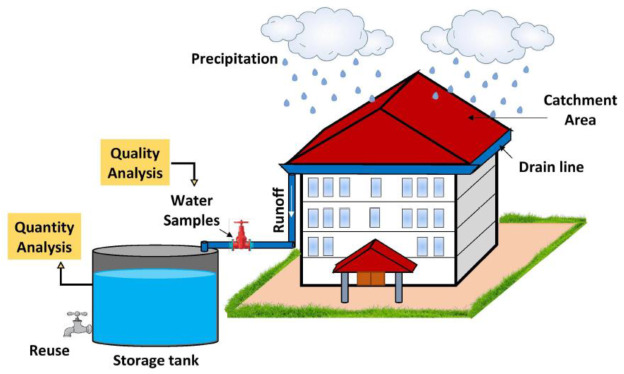Rainwater harvesting, an elegantly simple technique, enables the collection of raindrops for future utilization--drinking water, agriculture, gardening, and for more uses. By constructing systems that capture, store, and redistribute this liquid gold (refers to water here), we can transform the way we approach water conservation. The beauty of these eco-friendly systems lies not only in their simplicity but also in the myriad ways they allow us to repurpose this essential resource.
How Rainwater Harvesting Can Be Utilized in Different Ways?
Consider the interconnected connection of gathering rainwater and cultivation--a field where nature's treasures (water) and human resourcefulness unite to maintain life. Here are more different ways rainwater can be harvested in different areas for several purposes.
Agriculture: In parched lands, where the heavens seemingly cry out in despair, every droplet of rain is precious. By implementing clever resource management techniques, we can harness these gifts from above to transform desolate fields into green pastures (to a certain extent or even completely). Elaborately put, sophisticated irrigation systems in rural places/desert areas can distribute the collected rainwater (through rainwater harvesting), providing sustenance for water-starved crops and contributing significantly to the lush, green world we once only dreamt of.
For example: Utilizing rainwater harvesting in a desert region, an innovative agroforestry project can be developed, using the collected water to grow drought-tolerant trees and plants that help combat desertification while also providing resources for the local inhabitants.
Parched Areas (like desert): In regions where water scarcity prevails--like desert regions, capturing rainwater for everyday use is truly priceless. Parched lands can bask in a refreshing oasis when even splashes are as rare as liquid gold. Eagerly, rooftops and courtyards metamorphose into catchment areas for invaluable runoff, collecting droplets destined to quench parched throats.
This liquid treasure (through rainwater harvesting in parched land) not only satiates one's thirst but is also refined for domestic consumption--irrigation, household use--a revolution in resource management.
Urban Landscapes: By incorporating catchment areas atop skyscrapers or within grassy
courtyards, cities can wring out every ounce of sustainability from the cloudbursts above. Water collected thusly becomes a resource fit for both household duties and environmental endeavors. From nurturing urban gardens to flushing toilets, the versatile droplets bestow eco-friendly solutions upon the townsfolk.
Other Techniques of Rainwater Harvesting Implemented in Various Places
There are myriad other ways collected rainwater can be stored and utilized.
Case 1: In the picturesque hill and mountainous regions, ingenious inhabitants have ingeniously constructed diversion channels, such as the highly efficient 'guls' or 'kuls' of the Western Himalayas.
These marvels of human innovations for rainwater harvesting--groundwater replenishment--work remarkably well in balancing the equilibrium between human necessity--crop irrigation, domestic use, and environmental sustainability--combating drought; conserving water resources (primarily supporting agricultural endeavors).
Case 2: In the fertile flood plains of Bengal, enthusiastic farmers have adopted inundation channels--water distribution methods--to quench the thirst of their extensive fields. Designed to flow naturally with flood water, these channels create harmony with nature while simultaneously bolstering crop yields.
Case 3: Rooftop rainwater harvesting--filtration systems, storage tanks--is another clever practice popular in arid states like Rajasthan, where every precious drop counts. By effectively optimizing the collection and preservation of freshwater for future use--improved access, this technique excels not only in its functional nature but also as a demonstration of human ingenuity--transforming a house's very roof into a support system for its residents.
Case 4: The arid landscapes of Jaisalmer and Rajasthan pose challenges that the locals met with ingenuity by transforming agricultural fields into rain-fed storage structures (places where rainwater can collect and moisten the soil) known as 'khadins' and ‘Johads,’ respectively.
These remarkable feats of engineering mastery serve as improvised but useful sanctuaries for rainwater, allowing the collected rainwater to seep into parched soil long after seasonal storms have abated. Also, these unique techniques of rainwater harvesting--for moistening soil--enable to maintain fertility even in times of scarcity.
Case 5: Rooted in the heart of the arid terrains of Rajasthan, particularly in the regions of Bikaner, Phalodi, and Barmer, lies an ingenious rooftop rainwater harvesting technique--the time-honored tankas.
These water-storing tankas, known for their ecological innovation and traditional charm, have been beautifully integrated into the architecture of local houses and courtyards. Essential to the preservation of rainwater, tankas exhibit a powerful combination of heritage and practicality--a lifeline in desert regions--that has endured throughout the years in water-deficient areas.
With their uncanny ability to capture and store every last drop of precious rainwater that graces Rajasthan's parched landscape, tankas bear witness to mankind's unwavering resilience in the face of nature's stingy reign.
A quintessential example would be nestled within the labyrinth of earthen lanes that constitutes a typical Rajasthani village: here, a cluster of households is built to revolve around a central courtyard, which is home to a subterranean gem--the humble Tanka.
The construction of underground rooms adjacent to these tankas further exemplifies an age-old modus operandi for dealing with Rajasthan's scorching summer climate. Elaborately put, the proximity between the tanka and its adjoining chamber acts as a thermal buffer and moderates temperatures. Thus, these chambers give dwellers a sanctuary-like escape--natural coolant-- amid the sweltering heat while upholding eco-friendly living values.
As an ode to cultural heritage and environmental foresight, tankas also bridge generations in their determination to safeguard natural resources----maintaining ecological balance, protecting ecosystems, and sustaining biodiversity.
Besides, the challenge now is to protect and refresh native know-how for present-day eco-conscious efforts that cross boundaries--these tankas and other techniques can prove useful in overcoming those difficulties.
This long-established method of civilization must be adapted from Rajasthan's innovative water conservation systems by others who suffer from similar water problems. Reason: different water harvesting methods--that cost less---can make a world of difference in securing our planet's sustenance for centuries to come.
Conclusion
Rainwater harvesting is an eco-friendly and cost-effective solution with numerous advantages--sustainable treasure. By applying rainwater collection techniques, you can protect water resources--groundwater replenishment, lower utility expenses, and encourage sustainability--environmental balance. Hence, embrace rainwater harvesting today and reap the multifarious benefits for both yourself and the environment.
If you want to get multimedia animations or videos developed on rainwater harvesting, then you can approach Nobel Learn--a known player in educational content.


